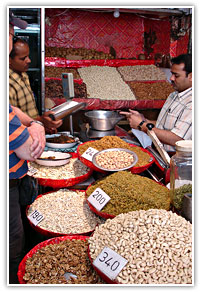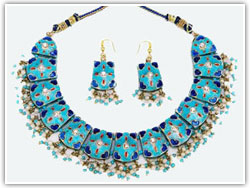|
|
Shopping in North India
.............................................................................................................................................................................. |
| |
|
|
|
The richness of India's
traditional handcrafts is known across the world.
The traditions are still alive, not in some purely
commercialized and tourist-oriented recreation of
lost skills, but in the living traditions handed
on through families that have practiced them for
generations. The variety and the often
outstandingly high quality of the work is still
astonishing. Each region has its own specialities.
Stone carving in India has its old tradition since
the time of Taj Mahal and is being practiced till
date by the next generation of these families.
Paper-mache of Kashmir, cane work pottery and
leather work of are specialty of the the Indian
state of Kashmir. South India is famous for the
Wood carving and metalwork. Indian Sandalwood,
Indian rose wood, walnut in Kashmir are to name
when it comes to wooden products in India.
Metalwork of North India, Indian bird ware in
Andhra, |
 |
|
|
Indian bronzes of the south are some more specialities
to name some.
Shopping in India is an experience as
India being the one of the most reasonable market in the
South Asia. Import from India are increasing to all over
the world. Jewellery of India, Carpets of India and
Marble work of Agra in India is getting popularity by
the tourist who are visiting India for travel purpose.
Kashmiri carpet makers of India enjoy their reputation
all over the world. Carpets of Indian Pure wool and
Indian silk are made superbly in North India. Tibetan
rugs, Indian Jewellery, Indian Gems, Rajasthani
silverwork, Indian diamonds, Indian lapis lazuli, Indian
moonstones, Indian aquamarine and Indian pearls are some
of the stones for which the capital of Rajasthan (Jaipur)
has made its name all over the world as most of the
stones are cut and polished in this city of India. If
you need any help and information about the products in
India we will be happy to provide you the needed
information.
Fabric in India
Textiles, especially cottons and silks, range from the
simplest of handmade garments to stunningly beautiful
and ornate saris. Silk brocades from Varanasi and
Kanchipuram, Patna, Murshidabad and Surat, are sought
after all over India. Rajasthan specializes in brightly
coloured tie and dye cottons, while Kashmir specializes
in woolens, especially the finest of goats' wool
Pashmina.
Indian Carpets
Kashmir has long had links with Persian carpet makers.
Pure wool, woven wool and silk are superbly made in
North India. Tibetan rugs are also widely available,
many made by Tibetan refugees living in India.
Jewellery
Gems have become India's leading export by value,
reflecting the importance both of the gemstones and the
finished Jewellery. Rajasthani silverwork, and diamonds,
lapis lazuli, moonstones and aquamarine are among the
precious stones, and Hyderabad is famous for its pearls.
Other Crafts
Stone carving in alabaster, marble and granite in both
North and South India, papier-mache in Kashmir, cane
work, pottery and leather work offers a tremendous range
of excellent goods from the smallest mementos to life
size statuary. Sandalwood and rose wood from the south,
and walnut in Kashmir, are the raw materials for some
beautiful carving and marquetry. Metalwork, especially
brass in the North, bidri ware in Andhra, and bronzes in
the south, are also famous. Here are some of the
selected destinations often visited by the tourists for
the shopping purpose. |
|
|
|
Bazaars of Old Delhi
The exploration of Delhi's markets could begin at
Chandni Chowk. There are fascinating lively
accounts of this bazaar as it was during the 17th,
18th and 19th centuries. Many of the shops here
are more than 100 years old, and the lanes are
full of surprises. Leading off Chandni Chowk is "Dariba
Kalan", the street of incomparable pearl, Khari
Baoli, the spice market and Kinari Bazaar for
trimmings and tinsel. In some of these bazaars the
items for sale are manufactured at site, which
lends a special charm to the shopping experience.
Well integrated into the culture of the old city,
these bazaars offer the visitor a glimpse of life
in Old Delhi. There are some antique stores behind
Jama Masjid, where the Meena Bazaar used to be
once. These offer items ranging from jewellery to
paintings and furniture and cater almost entirely
to tourists.
Contemporary
Supermarkets of Delhi |
 |
|
|
Moving further South are the upmarket
shopping centres of South Delhi - South Extension,
Greater Kailash I and II, Green Park and Hauz Khas
Village. These markets offer a combination of ethnic
chic and designer labels, Indian and international. One
of the more visible results of the liberalisation of the
Indian economy is the burgeoning on international
designer-wear outlets has set very interesting trends as
a market of the city. Wherein, a few years ago, an
association called "Dastakar" - established in the
tradition of providing village crafts through an
organised marketing system-set up a showroom in the
village. It didn't take long for entrepreneurs to
capitalize on the distinctly rural setting. Now the
village has a plethora of boutiques.
|
|
|
|
Shopping in
Rajasthan
Since long back Rajasthan has been famous for its
artistic designed jewellery with a variety of
precious and semi precious stones such as emerald,
garnet, agate, amethyst, topaz and lapiz lazuli
which look unique and elegant.
Jaipur is internationally renowned for its
exquisite Kundan (the art of setting precious
stones in gold) and meena (enamel) jewellery,
meenakari is also done in Nathdwara near Udaipur.
Lac and glass bangles are a special |
 |
|
|
attraction of Rajasthan and are made in a variety of
colours and designs in Jaipur and Jodhpur. Silver is
commonly worn by rural women and one can pick up old
Tribal Silver Jewellery as well.
The Printing
The village craftsman cuts small blocks by hand from
hard teak wood, one block for each colour in a design.
The printer then dips the wooden block into a
custom-mixed tray of fresh dye bath which is placed on
top of a small table on casters and moves down the
length of the cloth stamping with skilful precision. To
print a bedspread of 90"x108" the printers have to stamp
approximately 1400 times with different blocks of as
many as five or six colors, to cover the entire surface
of the fabric. Print colors are freshly mixed each day
by the color master in charge of each print workshop.
Printers maintain a complete record of the recopies of
various colors. Colour masters often have to amend the
recopies to compensate for changes in weather and
alterations in the dye lots.
Leather Ware
Jaipur, Jodhpur, Barmer and Jaisalmer are traditionally
known for their footwear. Incredibly comfortable and
sturdy, the jootis have artistically embroidered uppers.
Leather is also used for making musical instruments
especially percussion instruments (such as the tabla and
dhol) and the stringed instruments (like kamaycha) used
by Rajasthani folk musicians. Bikaner is known for its
painted lampshades, shields and vases made from camel
hide. Designer hand-bags, purses, belts, hats, stools
and collapsible chairs with graphic embroideries from
Tilonia village near Ajmer also make a good purchase.
The exhibition showcases items that are at once
moderately priced and high on quality. The deftly
executed wall hanging paintings on silk feature Rajput
and Mughal miniature reproductions, mythological scenes
and finely delineated floral themes.
Carpets and Durries
Rajasthan is famous for its traditional cotton durries
and woollen carpets specially made in Bikaner and Jaipur.
The durries are cool light rugs, generally found in
pastel shades with geometrical motifs which can even
liven up the dullest of all floors. The carpets though
are a bulky item to carry home are beautifully designed
that are generally based on Persian and Caucasian
styles.
Agra is one of the most important centres for
handicrafts, made of marble and softstone. The Mughals
were great patrons of arts and crafts. Empress Nur Jahan
took personal interest and was an accomplished artist in
Zari embroidery work. Agra's major handicraft products
besides inlay work are Leatherware, Brassware, Carpets,
Jewellery and embroidery work. Agra is also well known
for its sweets 'Petha' and 'Gajak' and saltish snack 'Dalmoth.'
The main shopping areas of the city are Sadar Bazar,
Kinari Bazaar, Munro Road, Sanjay Place, Raja-Ki-Mandi
and Near Taj Mahal Complex. |
|